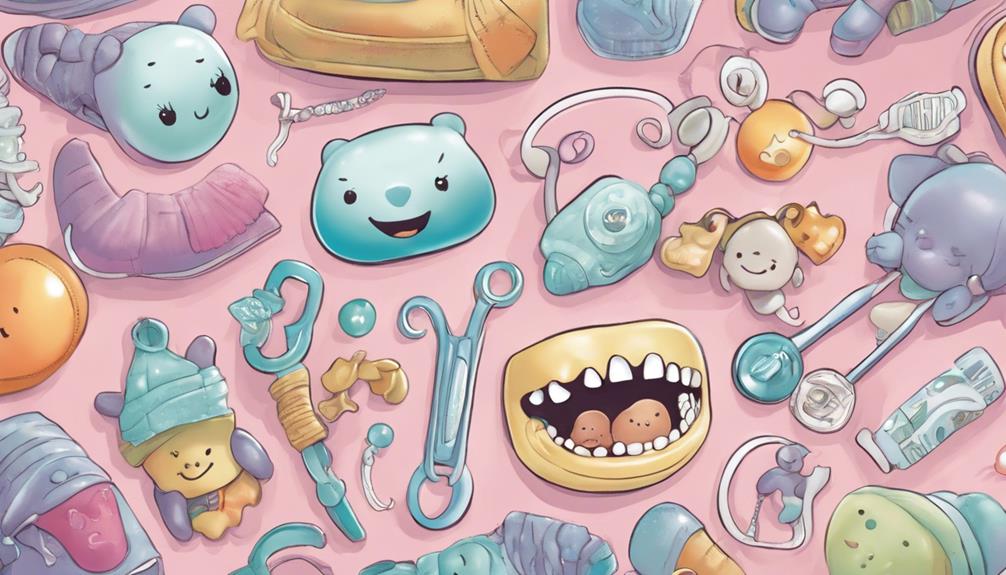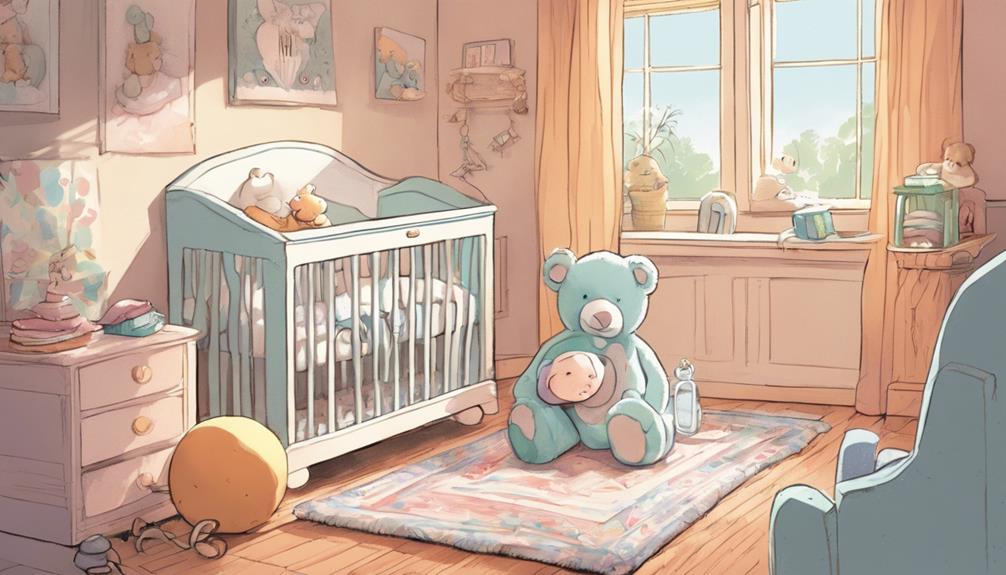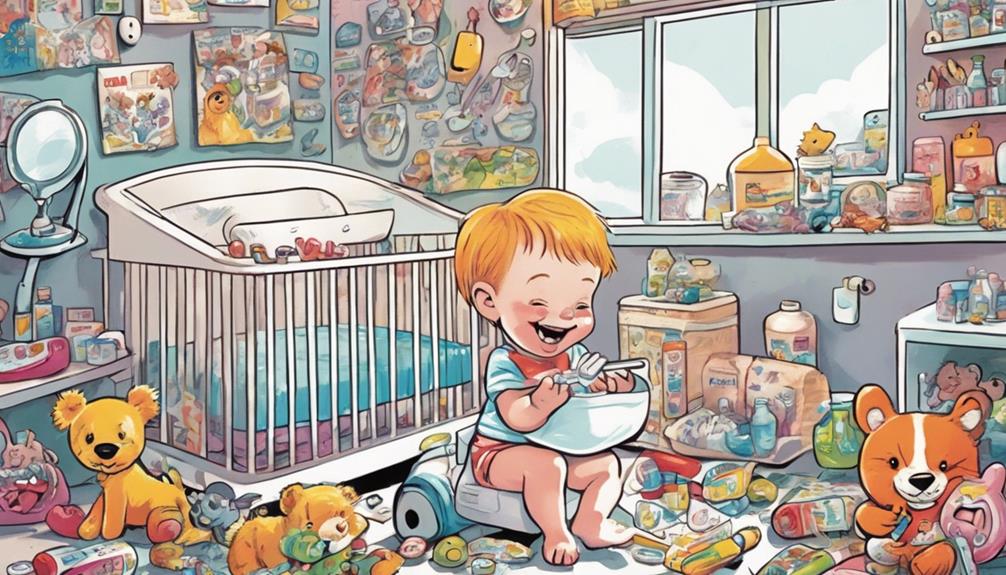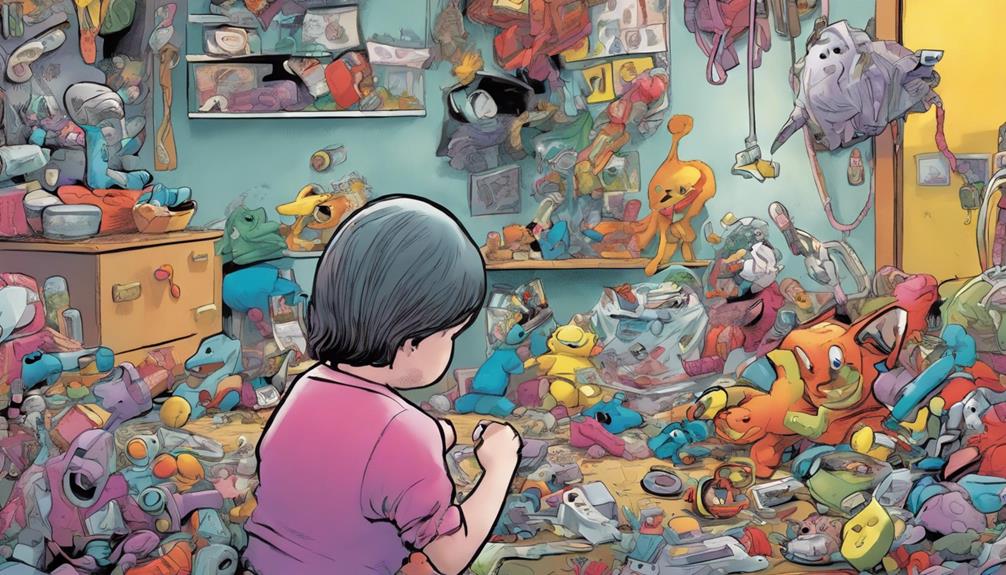Your baby usually starts teething around 6 months, beginning with the lower central incisors. These teeth typically emerge from 6 to 10 months. Next, the upper central incisors follow, appearing between 8 to 12 months. As your child grows, other teeth like the upper lateral incisors and molars come in, completing the set of baby teeth by age 3. These teeth are essential for eating, speaking, and overall health. Understanding your baby's teething journey can help you provide the best care. There's much more to discover about this critical developmental phase and how to support it effectively.
Key Takeaways
- Babies typically begin teething around 6 to 7 months, with the first tooth being the lower central incisors.
- The order of tooth eruption generally follows: lower central incisors, upper central incisors, lateral incisors, molars, and canines.
- Healthy baby teeth are crucial for proper nutrition, speech development, and future dental alignment.
- The first dental visit is recommended by age 1, ideally after the first tooth erupts, to monitor oral health.
Teething Timeline

Understanding the teething timeline helps you know what to expect as your baby's first teeth begin to emerge. Most infants will start teething around 6 to 7 months, with the first tooth typically being the lower central incisors. This is an exciting milestone, and you can track it using a baby teeth chart.
After the lower central incisors, expect the upper central incisors to come in between 8 to 12 months. As your child develops, they'll continue to sprout their primary teeth. Lateral incisors usually appear next, between 9 to 13 months for the upper jaw and 10 to 16 months for the lower jaw.
Then, first molars emerge between 13 to 19 months for the upper jaw and 14 to 18 months for the lower jaw. Keep in mind that individual teething timelines can vary widely. Some babies may start teething as early as 3 months or as late as 12 months.
Staying informed about these milestones will help you navigate this phase and provide the necessary care for your baby's emerging teeth.
Order of Tooth Eruption

The order of tooth eruption typically starts with the lower central incisors around 6 to 10 months, setting the stage for your baby's dental development.
You'll likely notice these first teeth emerging, and they play an essential role in your baby's ability to chew and speak.
Following the lower central incisors, the upper central incisors usually come in between 8 to 12 months.
Next, the upper lateral incisors typically erupt from 9 to 13 months, while the lower lateral incisors follow between 10 to 16 months.
As your baby grows, the upper first molars appear between 13 to 19 months, and the lower first molars erupt from 14 to 18 months.
Teething Symptoms

Teething can be a challenging time for both you and your baby, marked by symptoms like increased drooling and irritability as those little teeth make their way through the gums.
You'll likely notice gum swelling, which can contribute to your baby's discomfort and lead to fussiness. Many babies instinctively chew on objects or their fingers, hoping to relieve some of that pressure.
Sleep disturbances are another common aspect of the teething process. Your little one may struggle to fall asleep or wake more frequently during the night, making this phase tough for both of you.
You might see flushed cheeks or a slight rise in temperature, but remember that a true fever (over 100.4°F or 38°C) isn't typical for teething.
The combination of drooling, irritability, and general fussiness can make it hard to soothe your baby during this period. Understanding these teething symptoms can help you anticipate your baby's needs and offer comfort as they navigate this uncomfortable phase.
Being aware of these signs can make the teething process a little easier for both you and your baby.
Soothing Teething Pain

Soothing your baby's teething pain can be done through various effective methods that provide comfort and relief. Teething can be tough for both you and your baby, but you can find ways to ease their discomfort. Here are some ideas:
- Gum Massage: Gently massaging your baby's gums with clean fingers can apply pressure and soothe sore spots.
- Cold Comfort: Offer cold teething rings or frozen washcloths. The cold helps numb pain and reduce swelling in their gums.
- Teething Biscuits: Provide teething biscuits for your little one to chew on. Just make sure to supervise them to avoid choking hazards.
- Pain Relievers: If your baby's teething pain seems severe, consult your pediatrician about over-the-counter pain relievers like acetaminophen or ibuprofen.
Importance of Dental Care

Taking care of your baby's teeth from the start is key to their long-term health.
Scheduling their first dental visit by age 1 and establishing a solid brushing routine will set them up for success.
Early Dental Visits
Establishing a dental home by scheduling your child's first visit by age 1 is essential for monitoring their oral health and preventing future issues. Early dental visits allow pediatric dentists to assess your child's teething process, offer tailored advice, and guide you on maintaining healthy dental habits.
Here are four reasons to prioritize that first dental visit:
- Prevent Cavities: Early check-ups help catch potential problems before they develop into serious issues.
- Fluoride Use Guidance: Pediatric dentists can provide advice on fluoride use to strengthen your child's teeth.
- Nutrition Tips: Dental visits can educate you about nutrition that supports your child's oral health.
- Empowerment: You'll gain knowledge to make informed decisions regarding your child's dental care.
Proper Hygiene Practices
Proper hygiene practices are essential for your baby's dental health, starting as soon as that first tooth appears. Establishing good oral hygiene routines early helps prevent tooth decay and sets the stage for a lifetime of healthy brushing habits.
Here's a quick guide to help you maintain your baby's dental care:
| Step | Action | Frequency |
|---|---|---|
| 1. Brush with Care | Use a soft-bristled toothbrush and fluoride toothpaste | Twice daily |
| 2. Check for Decay | Look for signs of cavities and discoloration | Daily |
| 3. Schedule Check-ups | Book dental appointments | Starting at age 1 |
| 4. Bottle Awareness | Avoid putting the baby to bed with a bottle | Every night |
| 5. Teach Spitting | Encourage spitting out excess toothpaste | As they grow |
Unsafe Teething Products

Several teething products can pose serious risks to your baby's health, so it's crucial to know which ones to avoid. Here are four unsafe options that you should steer clear of:
- Teething Tablets: Many contain belladonna, which can lead to severe side effects. The FDA has issued warnings against their use.
- Benzocaine-Based Teething Gels: These gels may cause methemoglobinemia, a dangerous condition that reduces oxygen in the blood.
- Amber Teething Necklaces: Not only do they lack scientific support for relieving teething pain, but they also pose significant choking and strangulation risks.
- Unapproved Products: The FDA hasn't approved any teething products claiming to relieve teething pain, so be cautious of such claims.
Instead of these harmful options, consult your pediatrician for safe alternatives to help manage your baby's discomfort.
Knowing the risks associated with these products can protect your little one and promote their well-being during this challenging phase.
Prioritize safety, and make informed choices for your baby's health.
First Dental Appointment

Scheduling your baby's first dental appointment is crucial after their first tooth erupts, ideally by their child's first birthday. The American Academy of Pediatrics recommends establishing a 'dental home' by this age to guarantee consistent care. Pediatric dentists specialize in treating young children, focusing on proper dental development and oral hygiene practices.
During this first dental appointment, you'll have the opportunity for early detection of potential dental issues. The dentist will check your baby's teeth and gums, offering guidance on how to maintain oral hygiene. It's a great time to discuss teething, pacifier use, and nutrition's impact on your child's dental health.
To prepare for the visit, gather any relevant medical history and jot down questions you may have about your child's oral care. This proactive approach will help you feel more confident and informed during the appointment.
Impact on Overall Health

Your child's baby teeth do more than just fill their smile; they greatly influence overall health and development. These decaying little teeth play a significant role in several aspects of your child's life, including: Baby teeth development can impact speech development, as they help with proper pronunciation and sound formation. Additionally, the health of baby teeth can affect the alignment of permanent teeth and the overall structure of the jaw. It’s crucial to prioritize good oral hygiene and regular dental check-ups to ensure healthy baby teeth development for your child.
- Chewing: Healthy baby teeth help with the shift to solid foods, ensuring your child gets the nutrition they need for growth.
- Speech Development: Baby teeth are important for forming sounds and words, aiding in your child's ability to communicate effectively.
- Alignment of Permanent Teeth: Proper spacing from baby teeth helps prevent future crowding and misalignment of permanent teeth.
- Overall Health: Good oral hygiene from the first tooth onward prevents dental issues that can affect your child's well-being.
When baby teeth are lost too early due to decay or trauma, it can lead to complications like alignment problems and difficulties with chewing or speaking.
As a result, prioritizing your child's oral hygiene is essential. These early care habits won't only maintain their baby teeth but also lay the foundation for healthy permanent teeth, ensuring a strong start to their overall health.
Cultural Perspectives on Teething

When it comes to teething, you'll find that different cultures have their own unique remedies and rituals.
Some families celebrate the arrival of a first tooth with special events, while others rely on herbal treatments to ease discomfort.
Understanding these diverse approaches can enrich your parenting experience and help you respect various traditions.
Cultural Teething Remedies
Many cultures have unique beliefs and practices surrounding teething, often incorporating specific remedies and rituals to help ease a child's discomfort. These cultural approaches can offer you valuable insights into soothing your little one during this challenging time.
Here are four common remedies that you might find interesting:
- Herbal Teas: In many cultures, chamomile tea is used to soothe teething pain, believed to have calming properties that ease discomfort.
- Cold Items: Some communities recommend giving babies cold washcloths or chilled fruits to gnaw on, which can numb sore gums and provide relief.
- Massage: Gentle gum massages with clean fingers are often practiced to stimulate the gums and ease pain.
- Traditional Foods: In certain cultures, specific foods are introduced during teething to help distract and soothe, reflecting local dietary customs.
Understanding these remedies can enhance your parenting experience and deepen your respect for diverse cultural practices.
Teething Celebrations and Rituals
Cultural practices surrounding teething often include unique celebrations and rituals that honor a child's development as they grow their first teeth. These moments are significant milestones, marked by family gatherings and heartfelt traditions.
For instance, in many Western societies, the legend of the tooth fairy brings excitement as kids receive gifts for their lost teeth, making the shift into this new phase enjoyable.
In parts of India, the 'Mundana' ritual highlights the importance of a child's first tooth. Families come together to ceremonially remove and celebrate this tooth, symbolizing growth and development.
Additionally, various cultures embrace specific herbal remedies and foods thought to ease teething discomfort, showcasing traditional beliefs in natural healing practices.
Teething isn't just about physical changes; it reflects cultural beliefs that the arrival of teeth can bring good luck and health to the child.
Celebrations surrounding teething vary widely, but they all share a common thread: a deep appreciation for the journey of growth that every child experiences. Embracing these rituals can make the teething process feel more special and connected to your cultural heritage.
Diverse Parenting Approaches
Different parenting approaches around the world shape how families address the teething process, blending traditional practices with modern solutions. You might find that cultural significance influences how you manage your infant's teething pain.
Here are some diverse practices to contemplate:
- Teething Celebrations: Some cultures host gatherings to celebrate a baby's first tooth, reinforcing family bonds and cultural heritage.
- Traditional Remedies: Many parents turn to age-old practices, using items like cold washcloths or chilled fruits to soothe discomfort.
- Herbal Remedies: Parents in certain cultures often resort to natural solutions, such as chamomile or clove oil, to alleviate teething pain.
- Community Support: In various communities, sharing experiences and remedies strengthens parenting approaches, fostering a sense of belonging.
Frequently Asked Questions
In What Order Should Baby Teeth Come Out?
When your child starts losing teeth, expect the lower central incisors to come out first, followed by the upper central incisors. Canines and molars follow, with all primary teeth gone by age 12.
What Teeth Should My Baby Be On?
You'll notice your baby's teeth coming in gradually. By age 3, they should have 20 primary teeth. If you're unsure about their progress, consult a pediatric dentist for guidance and reassurance.
Which Teeth Should Come First in Babies?
Teething timing typically starts with the tiny lower central incisors. You'll notice them emerge between 6 to 10 months, followed closely by the upper central incisors. It's an exciting journey into your baby's dental development!
When Do Molars Come in a Baby?
Molars typically start coming in between 14 to 19 months, with lower first molars appearing first. By around 31 months, your child will have most of their primary molars, aiding in chewing solid foods.
Conclusion
To conclude, understanding your baby's teething journey can make this challenging time a bit easier.
Did you know that by age three, most kids have a full set of 20 primary teeth? That's quite a milestone!
By recognizing the teething timeline and symptoms, you can soothe their discomfort and guarantee good dental care starts early.
Embrace this stage with patience and love, as it's just one of many exciting steps in your little one's growth!









